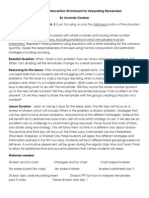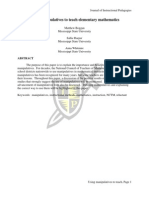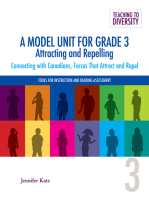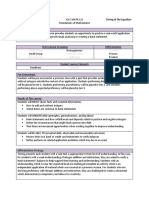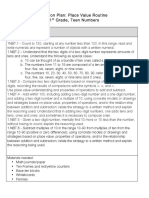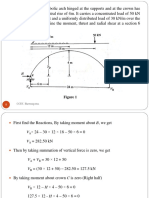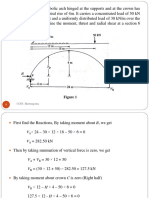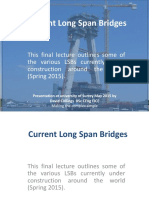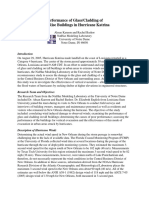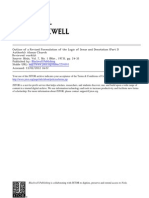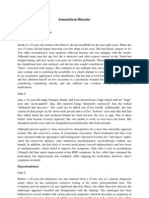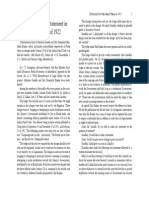Student Centered Teaching
Student Centered Teaching
Uploaded by
KarthiKeyanCopyright:
Available Formats
Student Centered Teaching
Student Centered Teaching
Uploaded by
KarthiKeyanOriginal Title
Copyright
Available Formats
Share this document
Did you find this document useful?
Is this content inappropriate?
Copyright:
Available Formats
Student Centered Teaching
Student Centered Teaching
Uploaded by
KarthiKeyanCopyright:
Available Formats
Student Centred Teaching Strategies
Student Centred Teaching Strategies
Dr. Sunaina Ahuja Dr. Savita Gupta
Professor and Associate Dean Professor
LPU-HRDC LPU-HRDC
sunaina@lpu.co.in savita.gupta@lpu.co.in
Lovely Professional University
The Key Takeaways
• How can I re-design the learning experience for my
students?
• Principles of Learner Centered Teaching
• Methods of Learner Centered Teaching
Lovely Professional University
Section 1
HOW CAN I RE-DESIGN THE
LEARNING EXPERIENCE FOR
MY STUDENTS?
Lovely Professional University
Dr. Sugata Mitra’s Hole-in-the-Wall Project
Lovely Professional University
Let’s Do It
• Find out about ‘Hole in the Wall Project’ by Dr.
Sugata Mitra and share your findings with the class.
• Time : 10 min.
Lovely Professional University
Poll
• The first experiment of ‘Hole in the Wall Project’ was
done by Dr. Mitra in :
– Andheri, Mumbai
– Kalkaji , New Delhi
– Dharavi Slum, Mumbai.
– Rajendra Nagar Slum, Bangalore
Lovely Professional University
Poll
• Dr. Sugata Mitra’s hole in the wall project involved
experimental studies in :-
– Computer Science
– Biotechnology
– Educational Technology
– Theoretical Physics
Lovely Professional University
Let’s Discuss
• Introduce Dr. Sugata Mitra to the class.
Lovely Professional University
Dr. Sugata Mitra
• Born 12 February 1952
• Indian computer Scientist and Educational theorist.
• He is best known for his "Hole in the Wall" experiment, and
widely cited in works on literacy and education.
• He is Professor Emeritus at NIIT University, Rajasthan,
India.
• A Ph.D. in theoretical physics, he retired in 2019 as
Professor of Educational Technology at Newcastle
University in England, after 13 years there including a year
in 2012 as Visiting Professor at MIT MediaLab in
Cambridge, Massachusetts, USA.
• He won the TED Prize 2013.
Lovely Professional University
Let’s Discuss
• Briefly explain the Procedure and Results of Hole in
the Wall Project.
Lovely Professional University
The Hole in the Wall Project
• Author : Dr. Sugata Mitra
• In early 1999, some colleagues and I sunk a computer
into the opening of a wall near our office in Kalkaji, New
Delhi.
• The area was located in an expansive slum, with
desperately poor people struggling to survive.
• The screen was visible from the street, and the PC was
available to anyone who passed by.
• The computer had online access and a number of
programs that could be used, but no instructions were
given for its use.
Lovely Professional University
The Hole in the Wall Project
• What happened next astonished us.
• Children came running out of the nearest slum and
glued themselves to the computer.
• They couldn't get enough.
• They began to click and explore.
• They began to learn how to use this strange thing.
• A few hours later, a visibly surprised Vivek said the
children were actually surfing the Web.
Lovely Professional University
The Hole in the Wall Project
• We left the PC where it was, available to everyone on
the street, and within six months
– the children of the neighborhood had learned all
the mouse operations
– could open and close programs
– were going online to download games, music and
videos.
• We asked them how they had learned all of these
sophisticated maneuvers, and each time they told us
they had taught themselves.
Lovely Professional University
The Hole in the Wall Project
• Interestingly, they described the computer in their
own terms, For instance,
– the children's word for the hourglass symbol that
appears when a program is "thinking" was
"damru,"
– The mouse cursor was called "sui," or "teer,"
Lovely Professional University
The Hole in the Wall Project
• We repeated the experiment in two other locations:
– in the city of Shivpuri in Madhya Pradesh
– in a village called Madantusi in Uttar Pradesh.
• Both of these experiments showed the same result as
the Kalkaji experiment:
• The children seemed to learn to use the computer
without any assistance. Language did not matter, and
neither did education.
Lovely Professional University
The Hole in the Wall Project
• Over the next decade we did extensive research in
self-directed learning, in many places and through
many cultures, throughout the world.
• Each time, the children were able to develop deep
learning by teaching themselves.
• I decided to call the method of instruction we had
developed Minimally Invasive Education (MIE).
• The rest of the world continues to call it the Hole in
the Wall.
Lovely Professional University
Talk : Dr. Sugata Mitra
• Short film
https://www.youtube.com/watch?v=HE5GX3U3BYQ
• TED TALK: A must watch
https://www.youtube.com/watch?v=dk60sYrU2RU
Lovely Professional University
What is Learner-Centred Teaching?
• Teacher-led pedagogy - ‘lecturing, note-taking, and
memorizing information for later reproduction’
• Learner-centred approach shifts the focus of activity
from the teacher to the learners
▪ Emphasizes what the learners do as against what the
teacher does
• Based on constructivist theories
▪ Learners are not passive recipients of information; they
construct and reconstruct knowledge in order to learn
Lovely Professional University
Why do we need Learner-Centred Teaching ?
• Research shows that learner-centered methods
lead to
▪ Increased student engagement with the content
▪ Deep learning
▪ Long term retention
▪ Acquisition of critical thinking or creative
problem-solving skills
▪ Positive attitude toward the subject being taught
▪ Confidence in knowledge or skills
Lovely Professional University
Poll
Learner Centered Teaching shift the focus of activity to
what the ______ do as against what the _______ does
A : teachers, learner
B : learners, teacher
Lovely Professional University
Section 2
PRINCIPLES OF LEARNER
CENTERED TEACHING
Lovely Professional University
Let’s Do It
• Find Out the Principles of Learner Centered Teaching
by (Weimer 2002) and share your findings with other
participants.
• Time : 5 min.
Lovely Professional University
Five Principles to Learner-Centered
Approach (Weimer 2002)
1. Balance of Power:
– Give students power in making decisions
and contributions to the course
2. The Function of Content:
– Don’t feel stressed to cover everything and
remember, covering content and promoting
learning are mutually reinforcing!!
Lovely Professional University
Five Principles Continued
3. The Role of Teacher:
– Teachers would be “guides, gardeners, helpers”
not just deliverers or organizers of information
4. The Responsibility for Learning:
– Is the student’s responsibility.
5. The Purpose and Processes of Evaluation:
– Should be more about how much they are
learning than what grade they received.
Lovely Professional University
Poll
• As per the principles of learner centered teaching, the
role of a teacher is
• A : Sage on the stage
• B : Guide by the side
Lovely Professional University
Section 3
METHODS OF LEARNER
CENTERED TEACHING
Lovely Professional University
Role of Teacher
We won’t meet the needs for
more and better higher
education until professors
become designers of
learning experiences and
not teachers.
- Larry Spence, Ph.D. (2001)
The Pennsylvania State University
Lovely Professional University
Case Study: Exceptional Teacher
The winner of the USD 1-million annual Global Teacher Prize 2020 in
recognition of his efforts to trigger a quick-response (QR) coded textbook
revolution in India.
Lovely Professional University
Research Says…
The person who does the
work is the ONLY one who
learns.
Lovely Professional University
Look into Several Classrooms
• Who is working?
–Instructor
• Who is learning most?
–Instructor
Lovely Professional University
Who Should Be Working?
The student should
be the worker.
MAKE THE STUDENT
WORK!!
Lovely Professional University
Let’s Brainstorm
• How can You make your student work?
Lovely Professional University
Some learner-Centred methods
• Active learning
▪ Students solve problems, answer questions,
formulate questions of their own, discuss, explain,
debate, or brainstorm during class
• Collaborative/Cooperative learning
▪ Students work in teams on problems and projects
under conditions that assure both positive
interdependence and individual accountability
Lovely Professional University
TEACHING STYLES ACTIVITY
EXAMPLE ONE EXAMPLE TWO
The teacher was: The teacher was:
• Presenting facts without a context • Drawing on students’ experience
• Doing the majority of the talking • Coaching the students towards finding
• Directing the students every move the answers
• Supplying most of the answers • Modeling thought processes, rather
• Not discussing his/her thought than presenting facts
processes loud • Validating all students suggestions
What does the student feel: What does the student feel:
Lovely Professional University
How is the 2nd teaching example student-
centered?
Lovely Professional University
Activity Identify each teaching situation as ‘Teacher-
Centered‘(TC) or ‘Student-Centered‘(SC)
• A teacher teaching about density places different
substances (oil, food coloring, copper coin) in water
and has the class predict and explain the behavior of
these substances in water.
A. Teacher-Centered (TC)
B. Student-Centered(SC)
Lovely Professional University
• A teacher teaching about combination of circuits
draws a series and a parallel circuit on the board
points to each circuit and writes “series” or “parallel”
under it, and tells the class to repeat the words.
A. Teacher-Centered (TC)
B. Student-Centered(SC)
Lovely Professional University
• A teacher conducting a lesson about gravity drops a
ball to the floor in the class and then allows the class
to guess why it falls to the floor. The teacher writes
students’ responses on the board after brainstorming
and discussion the correct conclusion is drawn.
A. Teacher-Centered (TC)
B. Student-Centered(SC)
Lovely Professional University
Learner Centred Teaching Methods
Inductive Teaching
Flipped Classroom
Cooperative and Collaborative Learning
Self Organized Learning Environment (SOLE)
Lovely Professional University
• Inductive teaching and learning
▪ Students are first presented with challenges
(questions or problems) and learn the course
material in the context of addressing the
challenges.
▪ Includes inquiry-based learning, case-based
instruction, problem-based learning, project-based
learning, discovery learning, and just-in-time
teaching.
Lovely Professional University
Poll
• In ----------- teaching method students are first
presented with challenges (questions or problems)
and learn the course material in the context of
addressing the challenges.
• A : Constructivist
• B : Inductive
• C : Conclusive
Lovely Professional University
Flipped Classrooms
• Inverts traditional classroom teaching methods
• Delivers instruction outside of class
• Activities, discussions, “homework” in class
Lovely Professional University
Lovely Professional University
Examples of collaborative learning or
group work
Stump your partner
Lovely Professional University
Examples of collaborative learning or
group work
Think-pair-share/ Write-pair-share
Lovely Professional University
Examples of collaborative learning or
group work
Catch-up
Lovely Professional University
Examples of collaborative learning or
group work
Team-based learning (adapted from L.K. Michaelsen in
Davis, 2009)
Lovely Professional University
Examples of collaborative learning or
group work
Group problem solving
Lovely Professional University
Examples of collaborative learning or
group work
Fishbowl Discussion
Lovely Professional University
Self-Organized Learning Environments (SOLE)
• Dr. Sugata Mitra : Children group around Internet-
equipped computers to discuss big questions.
• The teacher merges into the background and observes
as learning happens.
Lovely Professional University
• Source : Jacquelyn O'Malley (2017) :
• This past year, I began teaching a new project-based
elective for middle school students called 3D
Storytelling, which combines humanities and
STEAM objectives.
• Students use the design process to create their own
pop-up books.
• Before they begin, they must build a foundation of
knowledge of both storytelling and paper
engineering.
Lovely Professional University
SOLE
• Many students have seen a pop-up book before, but
few, if any, have asked themselves, “How can I make
this?”
• To build the foundation of knowledge, my supervisor
encouraged me to adopt SOLE as my main approach.
• I was intrigued yet nervous. I wanted to empower
students to take more responsibility over their own
learning, yet so much about the approach went
against my teaching instincts.
Lovely Professional University
SOLE
• What would it look like if I were to hand over the
majority of my 55-minute class period to my
students?
• To my surprise, my journey with SOLE has exceeded
my expectations and greatly impacted my practices.
• SOLE is an effective method for fostering student-
centered learning
Lovely Professional University
The School in the Cloud
• Cloud-based, scalable approaches to self-directed
learning.
Lovely Professional University
References
• https://www.edutopia.org/blog/self-organized-
learning-sugata-mitra
• https://www.youtube.com/watch?v=HE5GX3U3BYQ
• https://www.edutopia.org/blog/getting-started-self-
organized-learning-environments-jacquelyn-omalley
• https://www.youtube.com/watch?v=dk60sYrU2RU
• https://www.oreilly.com/library/view/creating-
significant-
learning/9781118124253/xhtml/Chapter01.html
Lovely Professional University
Dr. Sunaina Ahuja Dr.Savita Gupta
sunaina@lpu.co.in savita.gupta@lpu.co.in
Lovely Professional University
You might also like
- LIT5203 Module 1 Analyzing A School Literacy ProgramDocument8 pagesLIT5203 Module 1 Analyzing A School Literacy ProgramSabryna Richardson100% (1)
- Ah 343 Test Bank This Is The Mental Health Test Bank For NursingDocument166 pagesAh 343 Test Bank This Is The Mental Health Test Bank For Nursingmary011daniel100% (1)
- 7 Reflect ZoneofproxDocument5 pages7 Reflect Zoneofproxapi-315537808No ratings yet
- Multi-Tiered Math Unit PlanDocument12 pagesMulti-Tiered Math Unit Planapi-432376359100% (1)
- NFDN 2007 Assignment 2Document7 pagesNFDN 2007 Assignment 2api-287705803100% (2)
- Edtc630 Muneebah Grant AssignmentDocument4 pagesEdtc630 Muneebah Grant Assignmentapi-550210411No ratings yet
- Math Lesson Plan: Macey Conrad Kathryn BrashierDocument4 pagesMath Lesson Plan: Macey Conrad Kathryn Brashierapi-355875049No ratings yet
- MST Primary Integrated6 UnitDocument25 pagesMST Primary Integrated6 Unitapi-248229122No ratings yet
- Taking Time To Understand TimeDocument9 pagesTaking Time To Understand TimeAgnes ChongNo ratings yet
- Lesson Plan For Intervention and Enrichment For Division With Interpreting RemaindersDocument13 pagesLesson Plan For Intervention and Enrichment For Division With Interpreting Remaindersapi-234842570No ratings yet
- Math Big Ideas NCSM Spr05v73p9 24Document16 pagesMath Big Ideas NCSM Spr05v73p9 24Naini SinghNo ratings yet
- Gold Rush Lesson PlanDocument8 pagesGold Rush Lesson Planapi-270003746No ratings yet
- Teaching PhilosophyDocument13 pagesTeaching PhilosophyhallieNo ratings yet
- Differentiated AssessmentDocument1 pageDifferentiated AssessmentCherylDickNo ratings yet
- Teaching With Student Texts: Essays Toward an Informed PracticeFrom EverandTeaching With Student Texts: Essays Toward an Informed PracticeRating: 2 out of 5 stars2/5 (1)
- Animal Law: Human Duties or Animal Rights?: October 2020Document47 pagesAnimal Law: Human Duties or Animal Rights?: October 2020Gabriel FloreaNo ratings yet
- Seminar 20 Multi Party NegotiationsDocument2 pagesSeminar 20 Multi Party NegotiationsNeil100% (1)
- Teaching Science Through InquiryDocument25 pagesTeaching Science Through InquiryLeopoldo Junevil T PilapilNo ratings yet
- MathNavigator MisconceptionsErrorDocument40 pagesMathNavigator MisconceptionsErrorasnidar79No ratings yet
- 2021 Social Sciences ATP Grade 5Document10 pages2021 Social Sciences ATP Grade 5Koketso SekwenyaneNo ratings yet
- LP 1 - KindnessDocument4 pagesLP 1 - Kindnessapi-582292570No ratings yet
- Formative Ass 1 Sept 30Document5 pagesFormative Ass 1 Sept 30api-539087810No ratings yet
- Turtles Race W Beaver Lesson PlanDocument6 pagesTurtles Race W Beaver Lesson Planapi-245081461No ratings yet
- Project Based Learning WebsitesDocument5 pagesProject Based Learning WebsitesMichelle RanoyNo ratings yet
- Conceptual Understanding in Mathematics - Granted, And.Document37 pagesConceptual Understanding in Mathematics - Granted, And.Kenneth Okoye100% (1)
- Gradual Release of Responsibility 3Document5 pagesGradual Release of Responsibility 3Plug SongNo ratings yet
- Gifted Programming Models Graphic Organizer: Candidates' Summary NotesDocument5 pagesGifted Programming Models Graphic Organizer: Candidates' Summary Notesapi-361030663No ratings yet
- Effective Strategies For Teaching Elementary MathDocument12 pagesEffective Strategies For Teaching Elementary MathRJ IconNo ratings yet
- Number PuzzleDocument35 pagesNumber Puzzlelnln462ln0% (1)
- (2006) Differentiating The Curriculum For Elementary Gifted Mathematics StudentsDocument8 pages(2006) Differentiating The Curriculum For Elementary Gifted Mathematics StudentsMaria GeorgopoulouNo ratings yet
- Teaching Math in The Primary Grades: The Learning Trajectories ApproachDocument4 pagesTeaching Math in The Primary Grades: The Learning Trajectories ApproachDainah BaitoNo ratings yet
- Maths Assignment 2Document16 pagesMaths Assignment 2api-361487933No ratings yet
- Classroom Management 2007Document17 pagesClassroom Management 2007zaheeru_ddin50% (2)
- Eric Digest: Carol Ann TomlinsonDocument2 pagesEric Digest: Carol Ann TomlinsonroylepayneNo ratings yet
- Lesson Plan On ColorsDocument4 pagesLesson Plan On ColorsAnonymous luvALWF5s7No ratings yet
- Kagan Lesson Plan 4th Grade Social StudiesDocument9 pagesKagan Lesson Plan 4th Grade Social Studiesapi-603442952No ratings yet
- Big Green Help ToolkitDocument83 pagesBig Green Help ToolkitDaisyNo ratings yet
- Grade 1 Unit 1 - First Month of School - Blackfoot Values of Respect and Kindness - Intro Into Literacy and NumeracyDocument48 pagesGrade 1 Unit 1 - First Month of School - Blackfoot Values of Respect and Kindness - Intro Into Literacy and Numeracyapi-353056866No ratings yet
- Reflection and Plan For Classroom TransitionsDocument2 pagesReflection and Plan For Classroom Transitionsapi-530415478No ratings yet
- Using Manipulatives To Teach Elementary Mathematics Geometry)Document6 pagesUsing Manipulatives To Teach Elementary Mathematics Geometry)Abu Afza Al-GhifariNo ratings yet
- Cooperative Learning in Inclusive ClassroomsDocument8 pagesCooperative Learning in Inclusive ClassroomsUsman ZiaNo ratings yet
- Math Lesson PlanDocument2 pagesMath Lesson Planapi-279988623No ratings yet
- Daily 5 Model PresentationDocument14 pagesDaily 5 Model Presentationapi-301987462No ratings yet
- Reflection For Scheme of Work, Lesson Plan, Material DesigningDocument2 pagesReflection For Scheme of Work, Lesson Plan, Material DesigningOwl90No ratings yet
- A Model Unit For Grade 3: Attracting and Repelling: Connecting with Canadians, Forces That Attract and RepelFrom EverandA Model Unit For Grade 3: Attracting and Repelling: Connecting with Canadians, Forces That Attract and RepelNo ratings yet
- Tiering & The EqualizerDocument5 pagesTiering & The EqualizerLori Voss- SchoonoverNo ratings yet
- The Beginner's Guide to Cooperative Learning: Make your learners your main teaching resourceFrom EverandThe Beginner's Guide to Cooperative Learning: Make your learners your main teaching resourceNo ratings yet
- Readingcomp PG 092810Document87 pagesReadingcomp PG 092810api-297750365No ratings yet
- Capacity Building For MathsDocument8 pagesCapacity Building For MathsAnup SaravanNo ratings yet
- 1076 Earth Day Report CardDocument9 pages1076 Earth Day Report CardkamalshahNo ratings yet
- 1.place Value Routine 1st Grade Lesson Plan PDFDocument4 pages1.place Value Routine 1st Grade Lesson Plan PDFNalica Budz RobNo ratings yet
- The Blanket Exercise Dec 12th 3Document9 pagesThe Blanket Exercise Dec 12th 3api-390378000No ratings yet
- Sgraffito Tiles LessonDocument3 pagesSgraffito Tiles Lessonapi-253939208No ratings yet
- Letter To Soldiers - Lesson PlanDocument2 pagesLetter To Soldiers - Lesson Planapi-391223280100% (1)
- The Grid As An Artistic Tool - Adhd Lesson PlanDocument5 pagesThe Grid As An Artistic Tool - Adhd Lesson Planapi-246390692No ratings yet
- Lesson Planning and Classroom Management Plan For Public Elementary Schools in MexicoDocument20 pagesLesson Planning and Classroom Management Plan For Public Elementary Schools in MexicoPaulina GómezNo ratings yet
- Unit Plan Social StudiesDocument13 pagesUnit Plan Social Studiesapi-321836157No ratings yet
- Science Differentiation BriefDocument5 pagesScience Differentiation BriefToh Yang100% (1)
- Classroom Behavior Activity WorksheetDocument13 pagesClassroom Behavior Activity WorksheetDianeWyattNo ratings yet
- Classroom Management 1Document4 pagesClassroom Management 1api-277061258No ratings yet
- 4th Grade Writing Lesson PlanDocument3 pages4th Grade Writing Lesson Planapi-403388857No ratings yet
- NCTM - 2000 - Using Homemade Algebra Tiles To Develop Algebra and Prealgebra ConceptsDocument7 pagesNCTM - 2000 - Using Homemade Algebra Tiles To Develop Algebra and Prealgebra ConceptsAli Şahan AvcıNo ratings yet
- Chapter 1 Teaching Mathematics in The 21st CenturyDocument12 pagesChapter 1 Teaching Mathematics in The 21st CenturyImroatus SholikhahNo ratings yet
- Structural Analysis - I, B. Tech., 4th Semester, Civil Engineering, Module-V, Part IDocument54 pagesStructural Analysis - I, B. Tech., 4th Semester, Civil Engineering, Module-V, Part IKarthiKeyanNo ratings yet
- Structural Analysis - I, B. Tech., 4th Semester, Civil Engineering, Module-V, Part - IIDocument35 pagesStructural Analysis - I, B. Tech., 4th Semester, Civil Engineering, Module-V, Part - IIKarthiKeyan100% (1)
- GCEK, BhawanipatnaDocument4 pagesGCEK, BhawanipatnaKarthiKeyanNo ratings yet
- About NIT Warangal:: "Learning Management System: "Document2 pagesAbout NIT Warangal:: "Learning Management System: "KarthiKeyanNo ratings yet
- GCEK, BhawanipatnaDocument4 pagesGCEK, BhawanipatnaKarthiKeyanNo ratings yet
- GCEK, BhawanipatnaDocument2 pagesGCEK, BhawanipatnaKarthiKeyanNo ratings yet
- 11-1 Wan-Brief Intro Use of Mineral Admixture in Concrete-2-26Document25 pages11-1 Wan-Brief Intro Use of Mineral Admixture in Concrete-2-26KarthiKeyanNo ratings yet
- Current Long Span BridgesDocument28 pagesCurrent Long Span BridgesKarthiKeyanNo ratings yet
- Chapter 5 CorrectedDocument43 pagesChapter 5 CorrectedKarthiKeyanNo ratings yet
- P18SEE0001 Design of Bridges L T P J C 3 0 0 0 3: Pre-Requisites: NilDocument2 pagesP18SEE0001 Design of Bridges L T P J C 3 0 0 0 3: Pre-Requisites: NilKarthiKeyanNo ratings yet
- Program Schedule: Day 1 1st July 2019Document2 pagesProgram Schedule: Day 1 1st July 2019KarthiKeyanNo ratings yet
- U15CET402 Strength of MaterialsDocument2 pagesU15CET402 Strength of MaterialsKarthiKeyanNo ratings yet
- Performance of Glass/Cladding of High-Rise Buildings in Hurricane KatrinaDocument7 pagesPerformance of Glass/Cladding of High-Rise Buildings in Hurricane KatrinaKarthiKeyanNo ratings yet
- Challenges For Faculty Motivation in Heis: National Education Policy 2019Document4 pagesChallenges For Faculty Motivation in Heis: National Education Policy 2019KarthiKeyanNo ratings yet
- Introduction To The Gnostic Shamanism of LightDocument4 pagesIntroduction To The Gnostic Shamanism of LightAdamjollygreen100% (1)
- Chapter 24 Last Home Coming and TrialDocument17 pagesChapter 24 Last Home Coming and Trialwinnots95% (22)
- Math 4 DLP - Q3W4 Day 1Document3 pagesMath 4 DLP - Q3W4 Day 1Aira VillanuevaNo ratings yet
- Lords of Gossamer & ShadowDocument17 pagesLords of Gossamer & ShadowValerio CriniNo ratings yet
- Katija Is BrilliantDocument1 pageKatija Is BrilliantKalli BoninNo ratings yet
- Example On The Analysis of Internal Stresses in Frames Due To Temperature Difference Using Force MethodDocument5 pagesExample On The Analysis of Internal Stresses in Frames Due To Temperature Difference Using Force MethodUbani Obinna Ranks100% (1)
- Master in Business Administration Course StructureDocument13 pagesMaster in Business Administration Course Structurechristopher adubaleNo ratings yet
- 01 Sps Violago Vs BA Finance & ViolagoDocument2 pages01 Sps Violago Vs BA Finance & ViolagoKelsey Olivar MendozaNo ratings yet
- Arsi University College of Behavioral and Educational Science General Psychology Assignment For 2 Year Afan Oromo Student (20%)Document5 pagesArsi University College of Behavioral and Educational Science General Psychology Assignment For 2 Year Afan Oromo Student (20%)Efrem WondaleNo ratings yet
- Laguna State Polytechnic University: Professor: Dr. Lucita G. Subillaga Reporter: Jean Paul V. Banay - M.A.Ed. - E.MDocument4 pagesLaguna State Polytechnic University: Professor: Dr. Lucita G. Subillaga Reporter: Jean Paul V. Banay - M.A.Ed. - E.MRyan Paul NaybaNo ratings yet
- Church Logic Sense Denotation 1Document11 pagesChurch Logic Sense Denotation 1Hugolin BergierNo ratings yet
- Somatoform DisorderDocument3 pagesSomatoform DisorderJunar M. BalasbasNo ratings yet
- Jurnal 3Document6 pagesJurnal 3Zaimatul HamdiyahNo ratings yet
- CALICUT Annual Quality Assurance Report 201011Document56 pagesCALICUT Annual Quality Assurance Report 201011abisgitNo ratings yet
- Multi Dimensional ScalingDocument18 pagesMulti Dimensional ScalinganuragshuklaibshydNo ratings yet
- Example Cutsheet - SRI Roofing MaterialDocument3 pagesExample Cutsheet - SRI Roofing MaterialPavan Kumar SNo ratings yet
- Cerebellum, Thalamus, and HypothalamusDocument40 pagesCerebellum, Thalamus, and Hypothalamusasep100% (1)
- IPCC Independent Investigation Into Surrey Police's Knowledge of The Alleged Illegal Accessing of Amanda (Milly) Dowler's Mobile Phone in 2002Document6 pagesIPCC Independent Investigation Into Surrey Police's Knowledge of The Alleged Illegal Accessing of Amanda (Milly) Dowler's Mobile Phone in 2002mlpfosterNo ratings yet
- Gandhi's Statement During The Trial of 1922Document4 pagesGandhi's Statement During The Trial of 1922Sadhana SrinivasanNo ratings yet
- Indy Oil Field Development Plan PDFDocument139 pagesIndy Oil Field Development Plan PDFMohamed Yousry100% (1)
- Vernacular Architecture of Kullu: Submitted By: Jagriti 13622Document25 pagesVernacular Architecture of Kullu: Submitted By: Jagriti 13622Shefali GoswamiNo ratings yet
- Ride InfoDocument33 pagesRide InfoSwati AthavaleNo ratings yet
- Twatt Band Territory - William Twatt (Bremner)Document18 pagesTwatt Band Territory - William Twatt (Bremner)Red RiverNo ratings yet
- For Sidney BechetDocument8 pagesFor Sidney BechetPaigeIvey-BondNo ratings yet
- Decision Support Systems and Executive Support SystemsDocument33 pagesDecision Support Systems and Executive Support SystemsSakshi JindalNo ratings yet
- Limitations of Z TheoryDocument6 pagesLimitations of Z TheoryAnand Verma100% (1)









